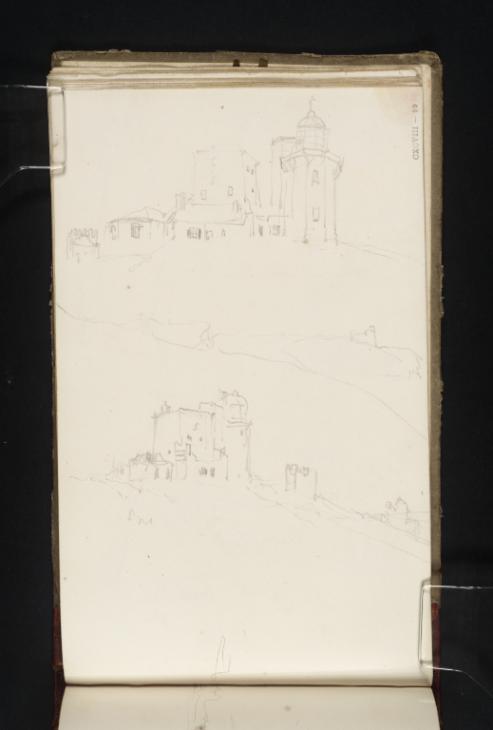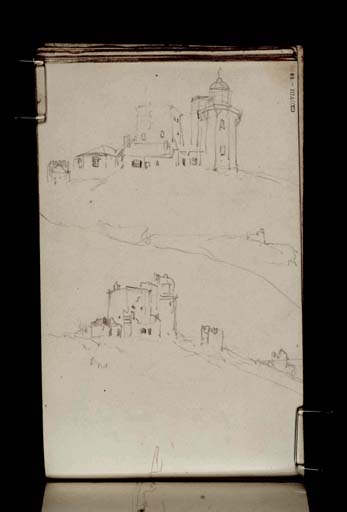Joseph Mallord William Turner ?South Foreland Lighthouse c.1821-2
Image 1 of 2
Joseph Mallord William Turner,
?South Foreland Lighthouse
c.1821-2
Joseph Mallord William Turner 1775–1851
Folio 69 Recto:
?South Foreland Lighthouse c.1821–2
D17324
Turner Bequest CXCVIII 69
Turner Bequest CXCVIII 69
Pencil on white wove paper, 187 x 113 mm
Partial watermark ‘T Edm | 18’
Inscribed by Turner in pencil ‘[?f m]’ towards bottom left
Inscribed by John Ruskin in red ink ‘69’ top right, ascending vertically
Stamped in black ‘CXCVIII – 69’ top right, ascending vertically
Partial watermark ‘T Edm | 18’
Inscribed by Turner in pencil ‘[?f m]’ towards bottom left
Inscribed by John Ruskin in red ink ‘69’ top right, ascending vertically
Stamped in black ‘CXCVIII – 69’ top right, ascending vertically
Accepted by the nation as part of the Turner Bequest 1856
References
1909
A.J. Finberg, A Complete Inventory of the Drawings of the Turner Bequest, London 1909, vol.I, p.606, CXCVIII 69, as ‘Lighthouse’.
1998
James Hamilton, Turner and the Scientists, exhibition catalogue, Tate Gallery, London 1998, pp.91, 133 note 22.
This page is dominated by two views of the South Foreland lighthouse near Dover, a topic Turner elaborates on several times in this sketchbook beginning on folio 8 recto (D17220).1 For a comprehensive history of the location, a list of the drawings which engage with it, and an outline of James Hamilton’s argument for the influence of the Bell Rock commission on Turner’s interests, see the entry for that page.
The topmost sketch seems to describe the lighthouse from the west, taking in the full extent of the buildings stationed behind the tower itself and recording their roofs and windows in some detail. In spite of the discrepancy in its title, an early monochromatic pencil and wash study by Turner entitled North Foreland Lighthouse, Kent dating from around 1793–95 (private collection) describes identical architectural forms to those depicted on the present page but from the northwest.2 The serpentine shapes rendered in metalwork that are clearly evident on the north wall of the foregrounded building in the watercolour are also described by Turner at the top of the west wall of the cubic building in the present sketch. For reasons stipulated in the entry for folio 8 recto, it seems possible that the watercolour has been misidentified.
Across the middle of this page Turner uses fluid lines to explore the topography of the Kent coast, as it slopes upwards on the left and cliffs sweep round into the distance on the right. Presumably this prospect describes the coastal view towards the north across St Margaret’s Bay, although the identification of the large building on the horizon at far right remains unclear. For a list of drawings of St Margaret’s both in the present sketchbook and elsewhere, see the entry for folio 35 verso (D17267).
The bottom segment of this page is occupied with another view of the lighthouse at South Foreland. Observed from behind, the prospect matches all the more convincingly with the North Foreland Lighthouse, Kent watercolour. A distinctive serpentine shape fixed to the west wall of the closest building is again marked here by Turner. Some brief hatching casts a shadow over the low parts of the structure on the left, and the hilly topography is rendered using multiple, almost shaky, lines. A possible inscription is marked towards bottom left, which may read ‘f m’, although the motivation for this is not explicit.
Maud Whatley
January 2016
See Charles Miller Ltd, ‘Lot 17’, Auction Catalogue, November 2015, p.8, accessed 30 October 2015, http://www.charlesmillerltd.com/Catalogues/ms031115/lot0017.html .
How to cite
Maud Whatley, ‘?South Foreland Lighthouse c.1821–2 by Joseph Mallord William Turner’, catalogue entry, January 2016, in David Blayney Brown (ed.), J.M.W. Turner: Sketchbooks, Drawings and Watercolours, Tate Research Publication, February 2017, https://www


